Physical Similarity Simulation of Deformation and Failure Characteristics of Coal-Rock Rise under the Influence of Repeated Mining in Close Distance Coal Seams
Abstract
:1. Introduction
2. The Proposition of Accurate Laying and Excavation Method of Similarity Simulation Model in Roadway of Special Surrounding Rock Structure
2.1. Basic Process of the Test Method
- 1.
- Making roadway model.
- 2.
- Labeling positioning and drawing line.
- 3.
- Presetting roadway model.
2.2. The Advantages of this Experimental Method
3. Overview of the Project
4. Experiment Plan of the Physical Similarity Simulation
4.1. Test Equipment and Test System
4.2. Experimental Materials and Making Similar Models
- Determination of similar materials and ratio number. The selection of similar materials and the determination of reasonable ratio number are crucial to obtain accurate and reliable results of similar simulation experiment. According to the mechanical parameters of actual coal and rock strata and similarity theory, the geometric similarity ratio of the model , the density similarity ratio = 1.5, the stress similarity ratio , and the time similarity ratio were chosen. Similar materials (Figure 6) choose sand as aggregate, lime and gypsum as cementing materials, and mica powder was spread between layers of coal and rock to simulate bedding. According to the calculation method of the strength value of coal and rock mass simulated by similar materials, the strength test of similar materials with different proportions was carried out for the main coal and rock strata. After repeated adjustment, the reasonable ratio number of similar materials for each coal and rock strata was obtained, as shown in Table 1.Figure 6. Main similar materials.Table 1. Similar material ratio and mechanical parameters.
Rock Stratum Number Thickness
(m)Lithology Proportion Number Model Thickness
(cm)Density
(g/cm3)Lamination Thickness
(cm)Layer Number Weight of Water Compressive Strength
(MPa)9 1.5 muddy siltstone 355 6 1.58 2.0 3 1/9 0.63 8 3.5 fine sandstone 473 14 1.55 2.0 7 1/9 0.57 7 1.6 16#coal 773 6.4 0.93 2.0 3 1/9 0.08 6 6 siltstone 373 24 1.70 2.0 12 1/9 0.75 5 0.3 silty mudstone 582 1.2 1.46 1.2 1 1/9 0.51 4 2.5 17#coal 773 10 0.93 2.0 5 1/9 0.08 3 15.2 gray fine sandstone 472 60.8 1.55 2.0 30 1/9 0.56 2 2.05 18#coal 773 8.2 0.93 2.0 4 1/9 0.08 1 6.35 mudstone 573 25.4 1.42 2.0 13 1/9 0.46
- 2
- Model design. According to the size of roadway, the true thicknesses of each coal and rock strata, the geometric similarity ratio, the size of test bench, and others, the size of the roadway model and its thicknesses of each coal and rock strata were determined, then the model design diagram was drawn. Before the model was laid, the quality of sand and lime in each layer was calculated according to the real thicknesses of each coal and rock strata, geometric similarity ratio, model test bench size, similar material density and ratio number. Then, the preparation of weighing ratio and mixing of similar materials was completed.
- 3
- LPDLPRM. The positioning labels of the roadway model and pressure box were put on the test bench according to the drawing, the separation lines of the coal and rock strata were drawn, mark the names of the coal seam and rock strata. Then, the coal seams and rock strata were laid, respectively, using similar materials which had been matched. The coal seams and rock strata were laid one by one and compacted every 5 cm. In order to make the model layered obviously, a layer of mica powder was evenly spread on it as a weak layer after each strata of coal and rock was laid. When the model was laid to the marked position, the roadway model that has been made was embedded to the marked position. We continued these procedures until the model laying was completed. The test process is shown in Figure 7.
- 4
- Maintenance of model. Three days after the model was laid, the fixed steel plates in front and back of the model were removed. When the whole model was dry, there were no water marks, and the whole was gray, pressing hard on its surface will not produce obvious depression, indicating that the experimental requirements were met. Then, the dense observation grids were drawn to ensure accurately record the variation characteristics of surrounding rock cracks during roadway excavation. Thus far, the test model was completed, which is shown in Figure 8.
4.3. Process of the Experiment
5. Experiment Results and Analysis
5.1. Evolution Characteristics of Surrounding Rock Cracks
5.2. Analysis of the Results of Infrared Thermal Imager Detection
6. Conclusions
- It puts forward an accurate laying of model and precise excavation of roadway test method named LPDLPRM which can effectively solve the problem of accurate laying of model and precise excavation of roadway in physical similarity simulation test of roadway with special surrounding rock structures. Additionally, the neat excavation of roadway outline can be realized by this method, so that the monitoring data are accurate and reliable, which can provide reference for the physical similarity simulation test of this kind of roadway.
- Due to the influence of repeated mining disturbance, the cracks distribution of the surrounding rock of the coal-rock rise in the close distance coal seams shows the asymmetric characteristics and it was denser in coal pillar side than the other parts. With the lower coal seam being mined, the cracks of the surrounding rock increased gradually. Under this condition, measures should be taken to strengthen the support in coal pillar side and to control the asymmetric deformation.
- Under the influence of repeated mining in the close distance coal seams, the stress concentration of roadway surrounding rock was weakened due to the pressure relief of upper coal seam being mined. The abutment pressure increased significantly when the coal seam and the lower coal seam were mined, resulting in a sharp stress increase in the surrounding rock, and seriously influenced on stability of roadway. Therefore, in the case of repeated mining, the support of the coal-rock rise should be strengthened in the mining process of the coal seam where the roadway was located and the lower coal seam working face.
7. Patents
Author Contributions
Funding
Institutional Review Board Statement
Informed Consent Statement
Data Availability Statement
Conflicts of Interest
References
- Zhang, P.D.; Gao, L.; Liu, P.Z.; Wang, Y.Y.; Liu, P.; Kang, X.T. Study on the influence of borehole water content on bolt anchoring force in soft surrounding rock. Shock Vib. 2022, 2022, 2384626. [Google Scholar] [CrossRef]
- Gao, L.; Zhao, S.H.; Huang, X.F.; Ma, Z.Q.; Kong, D.Z.; Kang, X.T.; Han, S. Experimental study on surrounding rock haracteristics of gateway in Panjiang mining area. J. GZU (Nat. Sci.) 2022, 1–6. Available online: http://kns.cnki.net/kcms/detail/52.5002.N.20220412.0956.002.html (accessed on 13 April 2022).
- Yu, Y.; Shen, W.L.; Guo, J. Deformation mechanism and control of lower seam roadway of contiguous seams. J. Min. Saf. Eng. 2016, 33, 49–55. [Google Scholar]
- Chai, J.; Du, W.G.; Yuan, Q.; Zhang, D.D. Study on the mechanism of rock mass fracture around high internal pressure roadway by establishing physical similarity model. Opt. Fiber Technol. 2019, 48, 84–94. [Google Scholar] [CrossRef]
- Guo, J.G.; Li, Y.H.; Shi, S.H.; Jiang, Z.S.; Chen, D.D.; He, F.L.; Xie, S.R. Self-forming roadway of roof cutting and surrounding rock control technology under thick and hard basic roof. Journal of China Coal Society. J. China Coal Soc. 2021, 46, 2853–2864. [Google Scholar]
- Chen, S.J.; Wang, H.L.; Zhang, J.W.; Xing, H.L.; Wang, H.Y. Experimental study on low-strength similar-material proportioning and properties for coal mining. Adv. Mater. Sci. Eng. 2015, 2015, 696501. [Google Scholar] [CrossRef] [Green Version]
- Li, L.; Wang, M.Y.; Fan, P.X.; Jiang, H.M.; Cheng, Y.H.; Wang, D.R. Strain rockbursts simulated by low-strength brittle equivalent materials. Adv. Mater. Sci. Eng. 2016, 2016, 5341904. [Google Scholar] [CrossRef] [Green Version]
- Kong, H.L.; Wang, H.Z.; Gu, G.Q.; Xu, B. Application of DICM on similar material simulation experiment for rocklike materials. Adv. Civ. Eng. 2018, 2018, 5634109. [Google Scholar]
- Mei, C.; Fang, Q.; Luo, H.W.; Yin, J.G.; Fu, X.D. A synthetic material to simulate soft rocks and its applications for model studies of socketed piles. Adv. Civ. Eng. 2017, 2017, 1565438. [Google Scholar] [CrossRef] [Green Version]
- Chen, X.G.; Wang, Y.; Mei, Y.; Zhang, X. Numerical simulation on zonal disintegration in deep surrounding rock mass. Sci. World. J. 2014, 2014, 379326. [Google Scholar] [CrossRef]
- Huang, F.; Zhu, H.H.; Xu, Q.W.; Cai, Y.C.; Zhuang, X.Y. The effect of weak interlayer on the failure pattern of rock mass around tunnel-Scaled model tests and numerical analysis. Tunn. Undergr. Space Technol. 2013, 35, 207–218. [Google Scholar] [CrossRef]
- Sterpi, D.; Cividini, A. A physical and numerical investigation on the stability of shallow tunnels in strain softening media. Rock Mech. Rock Eng. 2004, 37, 277–298. [Google Scholar] [CrossRef]
- Kong, D.Z.; Li, Q.; Wu, G.Y.; Song, G.F. Characteristics and control technology of face-end roof leaks subjected to repeated mining in close-distance coal seams. Bull. Eng. Geol. Environ. 2021, 80, 8363–8383. [Google Scholar] [CrossRef]
- Lin, J.; Wang, Y.; Yang, J.H.; Wang, Z.S.; Cai, J.F. Simulation studies on stress field evolution of roadway excavation under different confining pressures. J. China Coal Soc. 2015, 40, 2313–2319. [Google Scholar]
- Chen, X.G.; Zhang, Q.Y.; Liu, D.J.; Zhang, N.; Li, S.C. A3-D geomechanics model test study of the anchoring character for deep tunnel excavations. Chin. Civ. Eng. J. 2011, 44, 107–111. [Google Scholar]
- Jongpradist, P.; Tunsakul, J.; Kongkitkul, W.; Fadsiri, N.; Arangelovski, G.; Youwai, S. High internal pressure induced fracture patterns in rock masses surrounding caverns: Experimental study using physical model tests. Eng. Geol. 2015, 197, 158–171. [Google Scholar] [CrossRef]
- Yan, H.; Zhang, J.X.; Feng, R.M.; Wang, W.; Lan, Y.W.; Xu, Z.J. Surrounding rock failure analysis of retreating roadways and the control technique for extra-thick coal seams under fully-mechanized top caving and intensive mining conditions: A case study. Tunn. Undergr. Space Technol. 2020, 97, 103241. [Google Scholar] [CrossRef]
- Hui, G.L.; Niu, S.J.; Jing, H.W.; Wang, M. Physical simulation on deformation rules of god-side roadway subjected to dynamic pressure. J. Min. Saf. Eng. 2010, 27, 77–81+86. [Google Scholar]
- Mishra, S.; Kumar, A.; Rao, K.S.; Gupta, N.K. Experimental and numerical investigation of the dynamic respone of tunnel in soft rocks. Structures 2021, 29, 2162–2173. [Google Scholar] [CrossRef]
- Shan, R.L.; Huang, B.; Zheng, Y.; Kong, X.S.; Zhang, S.P.; Zhang, L.Z. Development of similar simulation equipment for roadway support subjected to vertical dynamic loads. Chin. J. Geotech. Eng. 2018, 40, 1163–1173. [Google Scholar]
- Chang, J.C.; Li, D.; Xie, T.F.; Shi, W.B.; He, K. Deformation and failure characteristics and control technology of roadway surrounding rock in deep coal mines. Geofluids 2020, 2020, 8834347. [Google Scholar] [CrossRef]
- Oh, D.W.; Lee, Y.J. Analysis of pile load distribution and ground behaviour depending on vertical offset between pile tip and tunnel crown in sand through laboratory model test. J. Korean Tunn. Undergr. Space Assoc. 2017, 19, 355–373. [Google Scholar] [CrossRef] [Green Version]
- Li, Y.H.; Liu, D.Z.; Yang, S. Development and application of physical simulation test system for small and medium-sized tunnels based on biaxial motor loading. Chin. J. Geot. Eng. 2020, 42, 1556–1563. [Google Scholar]
- Yuan, Z.G.; Shao, Y.H.; Zhu, Z.H. Similar Material Simulation Study on Protection Effect of Steeply Inclined Upper Protective Layer Mining with Varying Interlayer Distances. Adv. Civ. Eng. 2019, 2019, 9849635. [Google Scholar] [CrossRef] [Green Version]
- Wang, Z.Y.; Dou, L.M.; He, J. Failure characteristics of rock bursts in steeply-inclined extra-thick coal seams under static-dynamic coupling loading. J. Min. Saf. Eng. 2021, 38, 886–894. [Google Scholar]
- Idinger, G.; Aklik, P.; Wu, W.; Borja, R.I. Centrifuge model test on the face stability of shallow tunnel. Acta Geotech. 2011, 6, 105–117. [Google Scholar] [CrossRef] [Green Version]
- He, M.C.; Gong, W.L.; Zhai, H.M.; Zhang, H.P. Physical modeling of deep ground excavation in geologically horizontal strata based on infrared thermography. Tunn. Undergr. Space Technol. 2010, 25, 366–376. [Google Scholar] [CrossRef]
- Li, H.L.; Bai, H.B.; Ma, D.; Tian, C.D.; Zhang, Q. Physical simulation testing research on mining dynamic loading effect and induced coal seam floor failure. J. Min. Saf. Eng. 2018, 35, 366–372. [Google Scholar]
- Ren, Y.F.; Ning, Y.; Qi, Q.X. Physical analogous simulation on the characteristics of overburden breakage at shallow longwall coalface. J. China Coal Soc. 2013, 38, 61–66. [Google Scholar]
- Shi, X.S.; Jing, H.W.; Zhao, Z.L.; Gao, Y.; Zhang, Y.C.; Ruodi, B. Physical experiment and numerical modeling on the failure mechanism of gob-side entry driven in thick coal seam. Energies 2020, 13, 5425. [Google Scholar] [CrossRef]
- Berthoz, N.; Branque, D.; Subrin, D.; Wong, H.; Humbert, E. Face failure in homogeneous and stratified soft ground: Theoretical and experimental approaches on 1g EPBS reduced scale model. Tunn. Undergr. Space Technol. 2012, 30, 25–37. [Google Scholar] [CrossRef]
- Feng, C.; Dong, S.; Lai, X.P.; Chen, J.Q.; Cao, J.T.; Shan, P.F. Study on rule of overburden failure and rock burst hazard under repeated mining in fully mechanized top-coal caving face with hard roof. Energies 2019, 12, 4780. [Google Scholar]
- Xue, J.H.; Wang, H.P.; Zhou, W.; Ren, B.; Duan, C.R.; Deng, D.S. Experimental research on overlying strata movement and fracture evolution in pillarless stress-relief mining. Int. J. Coal Sci. Technol. 2015, 2, 38–45. [Google Scholar] [CrossRef] [Green Version]
- Yang, K.; He, X.; Dou, L.T.; Liu, W.J.; Sun, L.; Ye, H.S. Experimental investigation into stress-relief characteristics with upward large height and upward mining under hard thick roof. Int. J. Coal Sci. Technol. 2015, 2, 91–96. [Google Scholar] [CrossRef] [Green Version]
- Zhang, S.K.; Lu, L.; Wang, Z.M.; Wang, S.D. A physical model study of surrounding rock failure near a fault under the influence of footwall coal mining. Int. J. Coal Sci. Technol. 2021, 8, 626–640. [Google Scholar] [CrossRef]
- Liu, P.Z.; Gao, L.; Zhang, P.D.; Wu, G.Y.; Wang, C.; Ma, Z.Q.; Kong, D.Z.; Kang, X.T.; Han, S. A case study on surrounding rock deformation control technology of gob-side coal-rock roadway in inclined coal seam of a mine in Guizhou, China. Processes 2022, 10, 863. [Google Scholar] [CrossRef]
- Gao, L.; Liu, P.Z.; Zhang, P.D.; Wu, G.Y.; Kang, X.T. Influence of fracture types of main roof on the stability of surrounding rock of the gob-side coal-rock roadway in inclined coal seams and its engineering application. Goal Geol. Explor. 2022, 1–8. Available online: https://kns.cnki.net/kcms/detail/61.1155.p.20220416.0838.002.html (accessed on 5 April 2022).
- Kong, D.Z.; Xiong, Y.; Cheng, Z.B.; Wang, N.; Wu, G.Y.; Liu, Y. Stability analysis of coal face based on coal face-support-roof-system in steeply inclined coal seam. Geomech. Eng. 2021, 25, 233–243. [Google Scholar]
- Ji, Y.M. Study on Infrared Characteristics of Bolt and Rock in Condition of Loading. Spectrosc. Spectr. Anal. 2010, 30, 659–662. [Google Scholar]
- Toubal, L.; Karama, M.; Lorrain, B. Damage evolution and infrared thermography in woven composite laminates under fatigue loading. Int. J. Fat. 2006, 28, 1867–1872. [Google Scholar] [CrossRef]
- Yang, Z.; Qi, Q.J.; Ye, D.D.; Li, X.; Luo, H. Variation of internal infrared radiation temperature of composite coal-rock fractured under load. J. China Coal Soc. 2016, 41, 618–624. [Google Scholar]
- Peng, Y.Y.; Lin, Q.C.; He, M.C.; Zhu, C.; Zhang, H.J.; Guo, P.F. Experimental study on infrared temperature characteristics and failure modes of marble with prefabricated holes under uniaxial compression. Energies 2021, 14, 713. [Google Scholar] [CrossRef]
- Ma, L.Q.; Li, Q.Q.; Cao, X.Q.; Zhou, T. Variation characteristics of internal infrared radiation temperature of coal-rock mass in compression process. J. China Univ. Min. Technol. 2013, 42, 331–336. [Google Scholar]
- Meola, C. A new approach for estimation of defects detection with infrared thermography. Mater. Lett. 2007, 61, 747–750. [Google Scholar] [CrossRef]
- Liu, S.J.; Wu, L.X.; Wu, H.P.; WU, Y.H.; Cheng, T.; Li, G.H. Quantitative studies of infrared radiation dark mineral uniaxial loading process. Chin. J. Rock Mech. 2002, 21, 1585–1589. [Google Scholar]


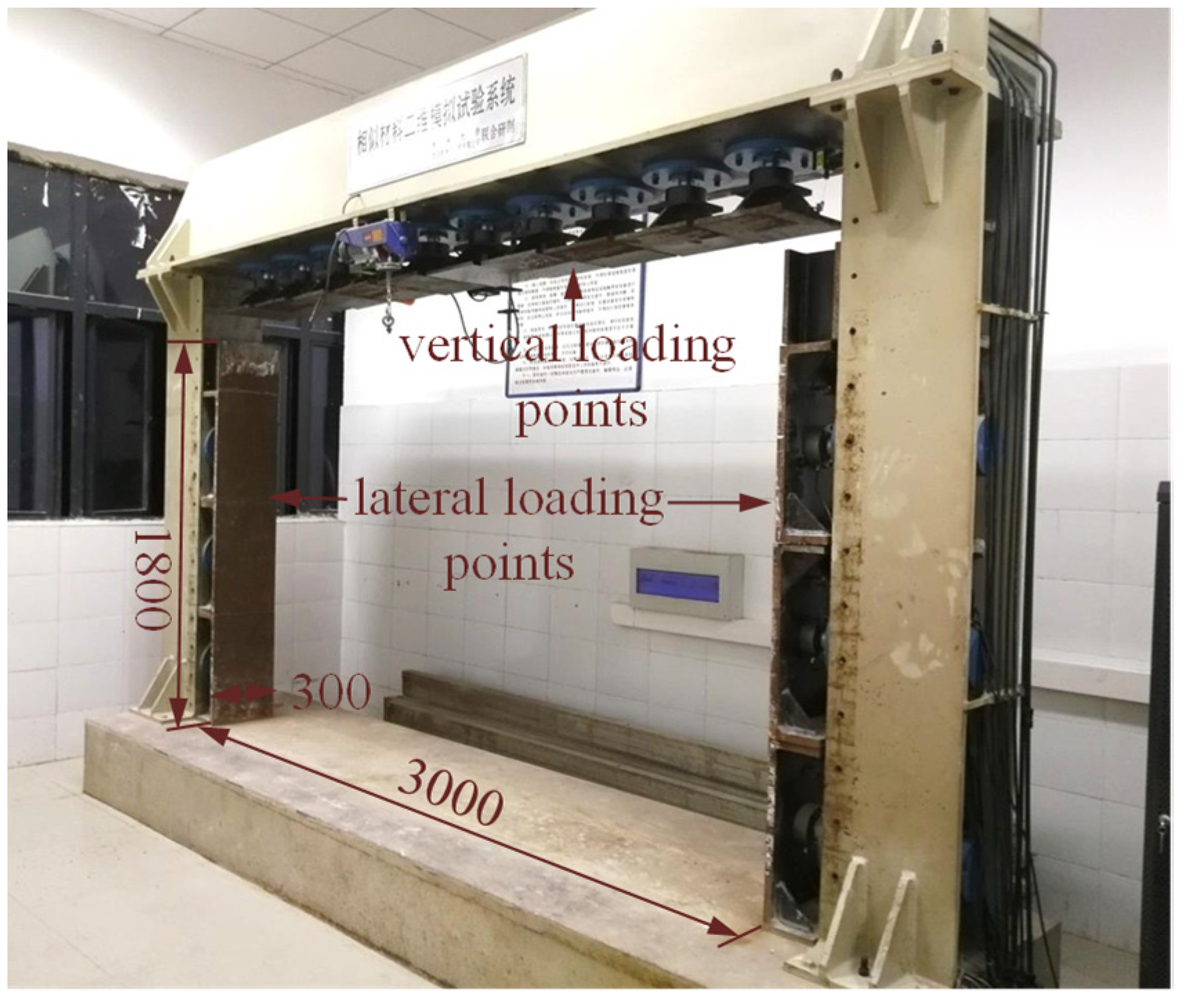

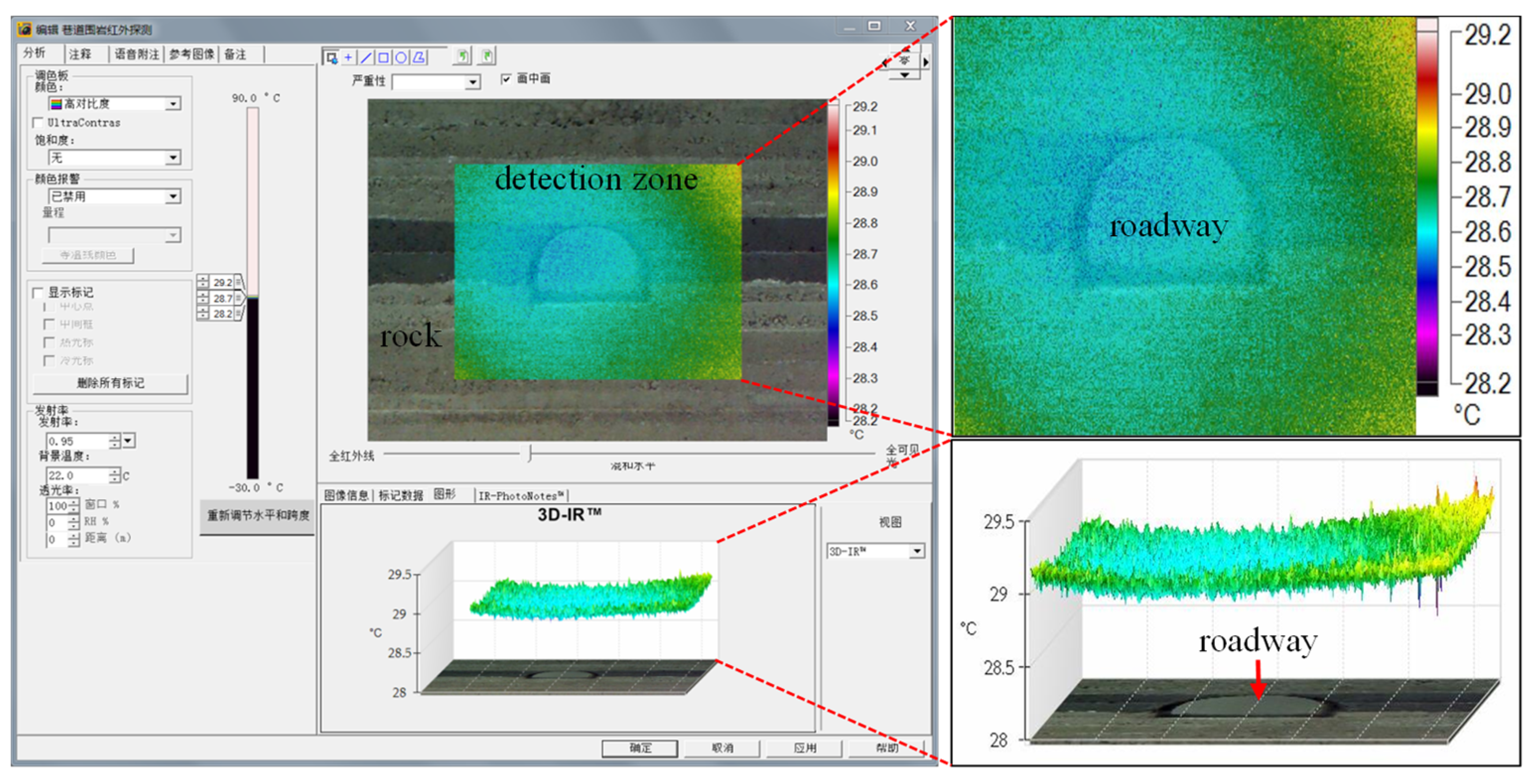
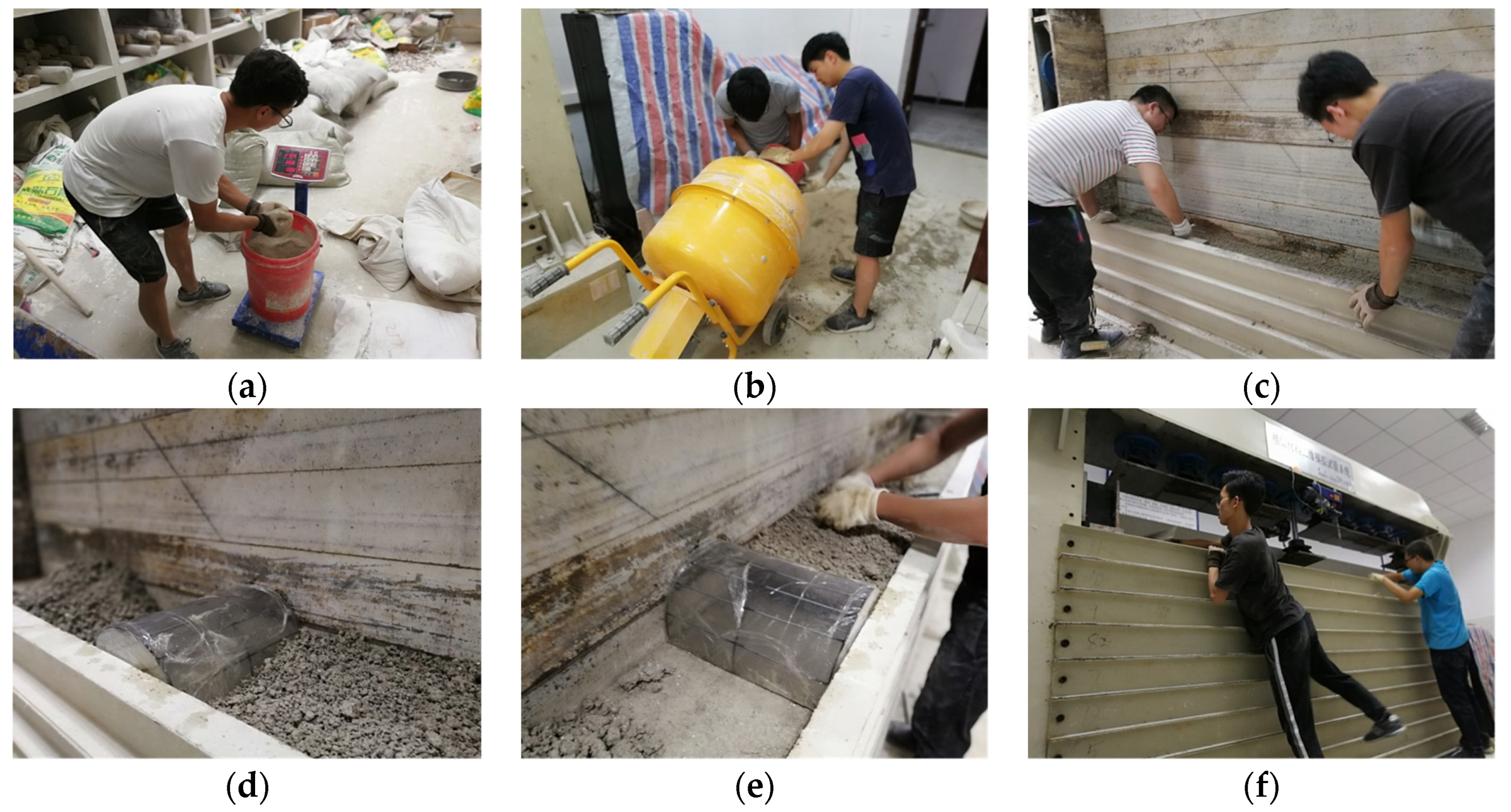
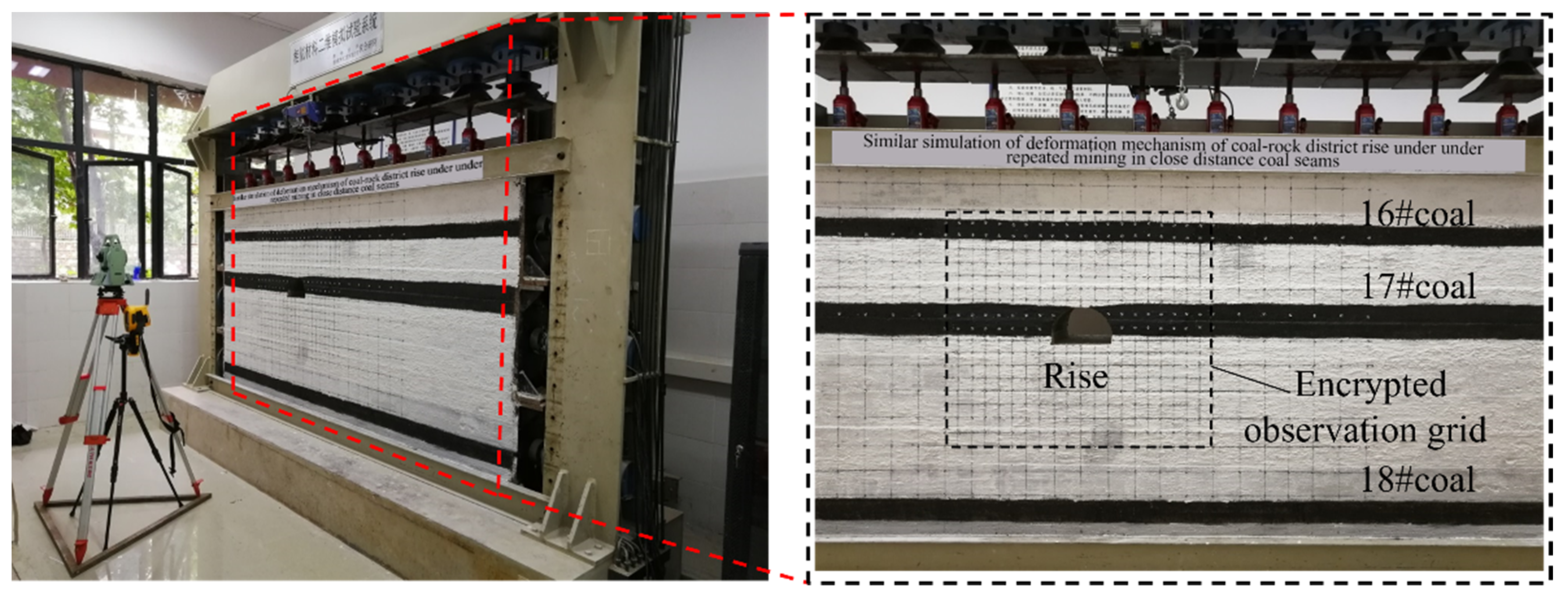

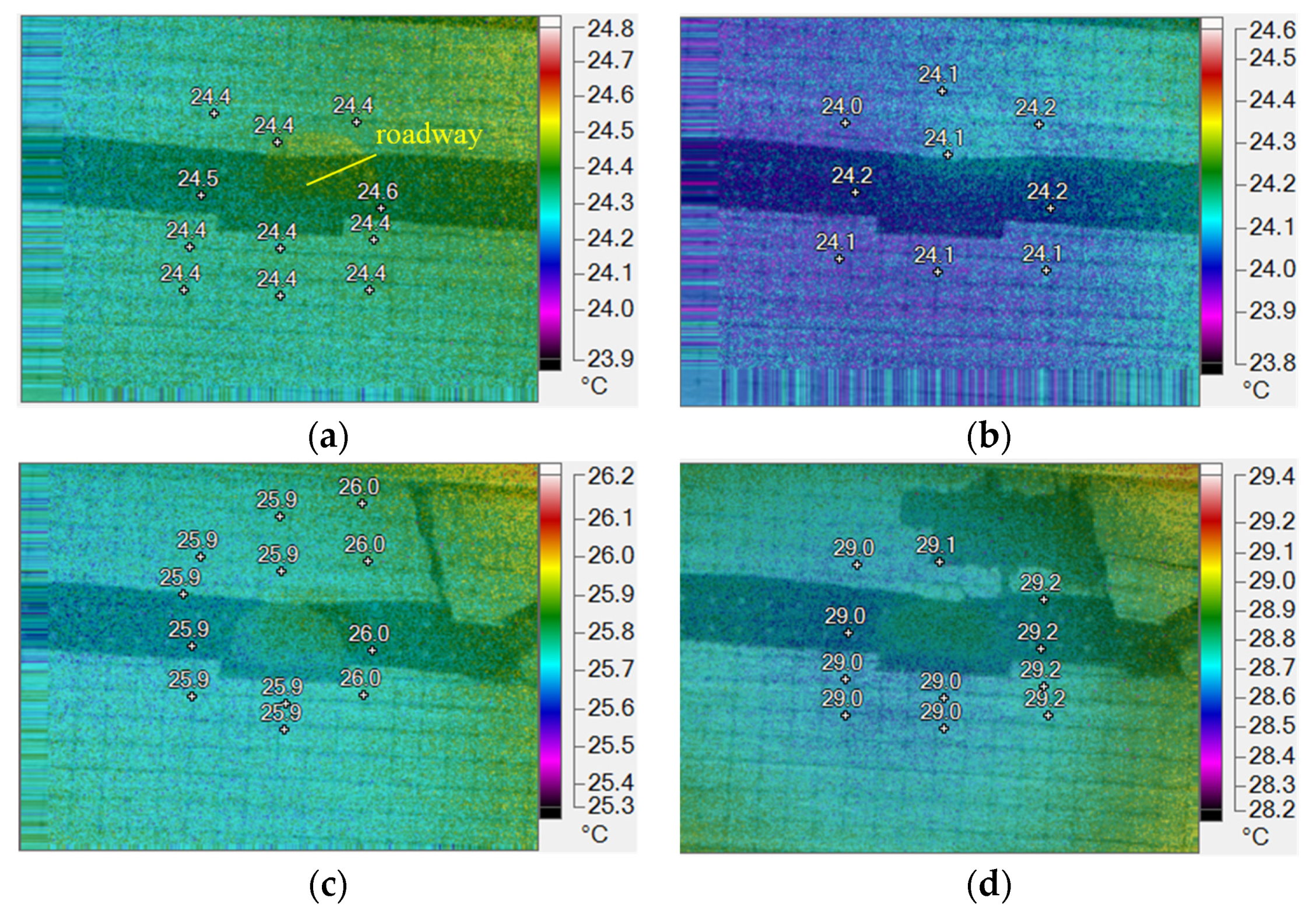
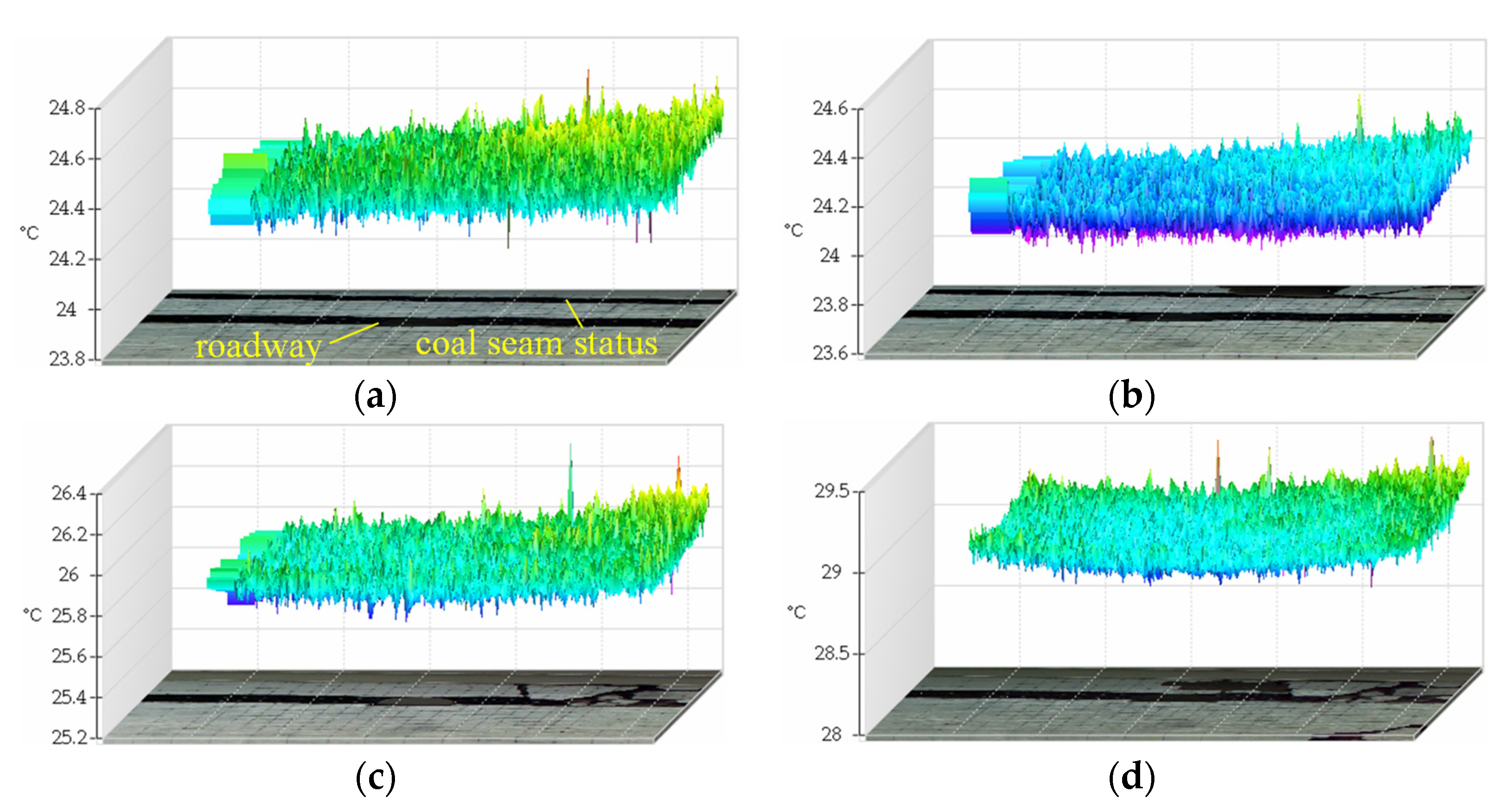
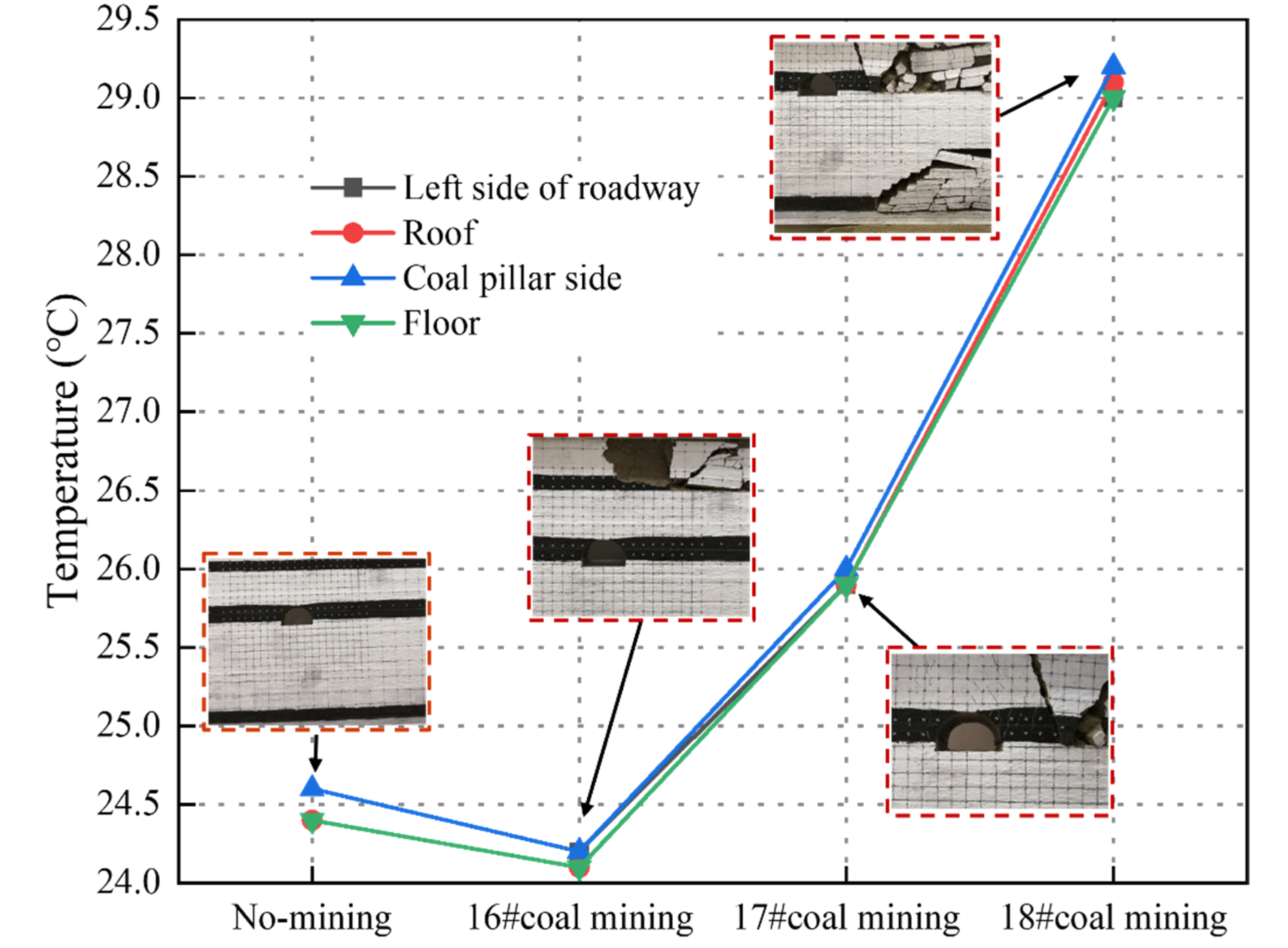
Publisher’s Note: MDPI stays neutral with regard to jurisdictional claims in published maps and institutional affiliations. |
© 2022 by the authors. Licensee MDPI, Basel, Switzerland. This article is an open access article distributed under the terms and conditions of the Creative Commons Attribution (CC BY) license (https://creativecommons.org/licenses/by/4.0/).
Share and Cite
Liu, P.; Gao, L.; Zhang, P.; Wu, G.; Wang, Y.; Liu, P.; Kang, X.; Ma, Z.; Kong, D.; Han, S. Physical Similarity Simulation of Deformation and Failure Characteristics of Coal-Rock Rise under the Influence of Repeated Mining in Close Distance Coal Seams. Energies 2022, 15, 3503. https://doi.org/10.3390/en15103503
Liu P, Gao L, Zhang P, Wu G, Wang Y, Liu P, Kang X, Ma Z, Kong D, Han S. Physical Similarity Simulation of Deformation and Failure Characteristics of Coal-Rock Rise under the Influence of Repeated Mining in Close Distance Coal Seams. Energies. 2022; 15(10):3503. https://doi.org/10.3390/en15103503
Chicago/Turabian StyleLiu, Pengze, Lin Gao, Pandong Zhang, Guiyi Wu, Yongyin Wang, Ping Liu, Xiangtao Kang, Zhenqian Ma, Dezhong Kong, and Sen Han. 2022. "Physical Similarity Simulation of Deformation and Failure Characteristics of Coal-Rock Rise under the Influence of Repeated Mining in Close Distance Coal Seams" Energies 15, no. 10: 3503. https://doi.org/10.3390/en15103503







